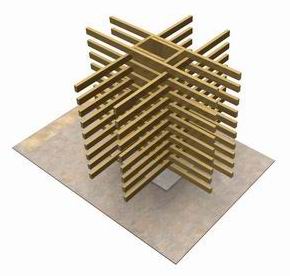by Rick Hill
Q.
We build kitchen cabinets and entertainment and office furniture. We have a conventional spray system, including a booth. I want info on the typical finishes you would deal with in a small, three- to five-man shop. Stain, solid color, and clear top coats.
We presently are using Sherwin Williams (cab-acrylic) finish almost exclusively. I know that they have a line of water-borne finishes, but our small retailer doesn't have a lot of information on technique or the best equipment for the application of the finish. Maybe you could supply a little information on the subject and recommend some water-based finish sources.
A.
The Sherwin Williams cab acrylic has a really nice clear color. Water bases (because of the lack of nitrocellulose) also have this same clear look. Some water-based finishes were originally tinted yellow just to match the lacquers people were using.
Water-based finishes have a few quirks that, once you are aware of, are easy to work with.
Water-based finishes will rust any non-stainless parts and fittings. So you may have to upgrade your spray equipment.
Water bases will be easy to spray and will lay down much like your Sherwin Williams, but in order to use them, you'll have to change a few of your sanding steps. If you’re spraying on maple, these finishes look great. If spraying on oak, you will need to do a lot of scuff sanding. The oak grain raises quite a bit when exposed to water.
Often, we mix a finely ground pigment stain, called a microlith, for water users. Microlith acts like a mix of dye stain and pigment stain. It also soaks into the grain. A water-based microlith stain will raise the grain, but because of its grain penetration it can be scuffed lightly before adding the sealer coat of water base. This allows your sealer coat to lay flatter and reduces further grain raise.
So, for water-based finishing, we recommend you apply a microlith (to get the color), let that dry and then scuff the surface with 220 to 320 stearated paper. Next, spray a heavy sealer coat and then a topcoat. Depending on the moisture content of the wood, you may have to scuff the sealer again before topcoating. On maple this is never necessary, but on oak it may be.
Dry times on water-based systems can be as fast as lacquers if you increase the air movement over the finished part. Warm, dry air is the best, but any air movement will help dramatically. Think of it as if your carpet was damp. A fan will pull more water out than a heater. On days with high humidity, you may have to wait longer to sand or recoat, but contrary to what you hear, dry time is not a problem.
As to sources of supply, you have a myriad of choices. All the major suppliers now have a water based finish. Sherwin Williams, Pratt and Lambert, Advantage Coatings, Guardsman/Lily, Valspar, and ML Campbell, along with a bunch of small-time manufacturers, are getting into it. My choice is to first find the best technically oriented sales guy in your area and use him to help. No matter whose product you use you will have start-up glitches. Support from your supplier will be the key to making it work.
Try calling other woodworkers to get some idea of what brands work well. You can use your local AWI or NKBA council to help in this search. Also call the local distributors in your area that service the market with laminate and hardware. They will know if anyone has recently switched to water and who you should talk with.
Of the several water users in my area, none have gone back to solvent after switching. Several had some real production problems at the start, but once they figured it out they stuck with it because of all the benefits, i.e.: no hazardous waste, no solvent fumes, no flammability problems, no employee health dangers.
I really think that if you are committed to making the change, it will work.
Rick Hill is an independent representative and consultant for industrial wood finishes. He has been involved in the woodworking industry for 12 years, and has been known to actually hold, shoot, and clean a spray gun.
If you have an industry related question, visit WOODWEB's Finishing Forum to post your question.
